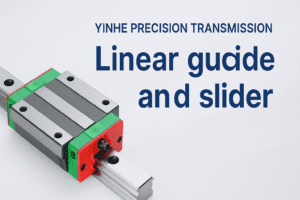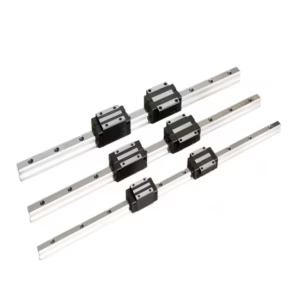Linear rails and bearings are fundamental components in many precision engineering systems, from CNC machines and robotics to automotive applications and medical devices. These systems are designed to facilitate smooth, precise linear motion with minimal friction. Whether you’re designing a machine tool, a conveyor system, or an automated robot, understanding the mechanics, types, and advantages of linear rails and bearings is essential for ensuring optimal performance and longevity.
In this article, we’ll dive deep into the function of linear rails and bearings, their types, how they work, and the key applications across industries.
What Are Linear Rails and Bearings?
Linear Rails
A linear rail (also known as a linear guide rail) is a precision component that provides a smooth path for linear motion. The rail is usually made of hardened steel or stainless steel to ensure durability and wear resistance. Linear rails are designed with a track system where a carriage or block moves back and forth, guided by rolling elements like ball bearings or rollers. They are essential in applications where smooth, accurate motion is required.
Linear Bearings
A linear bearing, on the other hand, is the component that rides on the rail and allows for the smooth movement of a machine part. It contains rolling elements (like balls, rollers, or even magnetic fields in advanced designs) that help reduce friction between the moving parts, facilitating high precision and efficiency in motion.
How Do Linear Rails and Bearings Work?
Linear rails and bearings work together to guide the motion of a system along a straight line. The basic working principle involves the carriage or bearing block traveling along the rail with minimal resistance, thanks to the rolling elements inside the bearing. Here’s a breakdown of how they function:
1. Rolling Elements
The linear bearing contains rolling elements such as balls or cylindrical rollers that are positioned between the rail and the carriage. These rolling elements allow the system to move with less friction compared to traditional sliding mechanisms.
2. Rail Surface
The surface of the rail is precisely machined to ensure that it provides a smooth, consistent path for the bearings. Typically, the rail is made of hardened steel or stainless steel to resist wear and provide long-lasting durability.
3. Carriage or Bearing Block
The bearing block or carriage holds the rolling elements and travels along the rail. It is designed to fit snugly on the rail to ensure a stable, smooth movement. The carriage is typically equipped with seals or covers to prevent contaminants from entering and to keep the system clean.
4. Lubrication
Lubrication is essential in ensuring smooth operation and reducing wear. Many linear bearings come pre-lubricated, but periodic maintenance or re-lubrication is often required to ensure optimal performance and longevity.
Types of Linear Rails and Bearings
There are several types of linear rails and bearings designed for different applications and requirements. The type of system you choose depends on factors like load capacity, speed, precision, and environmental conditions.
1. Ball Bearings (Ball Rail Guides)
Ball bearings are the most common type of linear bearings. They consist of small steel balls that rotate between the rail and the carriage. The ball bearings reduce friction significantly, allowing for smooth, high-speed movement. This type is ideal for applications requiring medium to high speeds and light to moderate loads.
Advantages:
High precision
Smooth movement with low friction
Suitable for moderate loads
Applications:
CNC machines
Automated assembly lines
3D printers
2. Roller Bearings (Roller Rail Guides)
Roller bearings use cylindrical rollers instead of balls. This design offers a larger surface area of contact with the rail, which allows roller bearings to handle heavier loads. Roller bearings are often used in industrial machines that require greater load capacity or where the motion is more demanding.
Advantages:
Better load capacity than ball bearings
Increased stability under heavy loads
Suitable for applications where high precision and high load are both required
Applications:
Heavy-duty machinery
Conveyors
Automotive testing rigs
3. Crossed Roller Bearings
Crossed roller bearings are designed for precision applications. The rollers are arranged in a criss-cross pattern, which allows for handling both radial and axial loads. These systems provide high rigidity, minimal backlash, and excellent accuracy, making them ideal for high-precision tasks where minimal movement is critical.
Advantages:
Extremely high precision
Ability to handle both radial and axial loads
Minimal backlash for highly accurate systems
Applications:
Semiconductor manufacturing
Medical imaging systems
Robotics requiring high precision
4. Magnetic Linear Bearings
Magnetic bearings use magnetic fields to levitate and guide the bearing block. These systems eliminate physical contact between the moving parts, making them ideal for environments where traditional bearings would suffer from wear or contamination. Magnetic linear bearings offer extremely smooth, frictionless movement and are used in highly specialized applications.
Advantages:
Contactless motion
Zero friction
Suitable for high-speed applications and clean rooms
Applications:
High-precision industrial equipment
Semiconductor and cleanroom environments
High-speed transport systems
5. Air Bearings
Air bearings are similar to magnetic bearings, but instead of magnets, they use a thin layer of pressurized air to create a frictionless gap between the bearing and the rail. These systems are often used in ultra-precise applications where even the slightest friction could affect performance.
Advantages:
Frictionless motion
Extremely high precision
Used in specialized, high-tech environments
Applications:
Metrology and precision measurement
High-speed spindles
Optical instruments
Key Applications of Linear Rails and Bearings
Linear rails and bearings are integral to a wide variety of industries due to their efficiency, precision, and versatility. Some key applications include:
1. CNC Machines
In CNC (Computer Numerical Control) machining, precision is everything. Linear rails and bearings are used to guide the movement of machine components such as the tool head and workpiece. The smooth, precise motion enabled by linear bearings ensures that parts are machined with the utmost accuracy.
2. Robotics
Robots, whether used in manufacturing or surgery, require linear motion to function. Linear bearings and rails provide the precise movement needed for robot arms and other robotic components. These systems ensure that robots can move with minimal error, whether they are assembling parts on an assembly line or performing delicate medical procedures.
3. 3D Printing
Linear rails and bearings are commonly found in 3D printers, where they guide the movement of the printhead and bed. The precision of these systems is critical for ensuring that 3D prints are accurate and meet design specifications.
4. Automotive and Aerospace Testing
In the automotive and aerospace industries, linear rails and bearings are used in test rigs and simulators to replicate real-world conditions for components. These systems are essential for testing parts like engine components, suspension systems, and control systems under precise conditions.
5. Medical Devices
Many medical devices, such as MRI machines, X-ray machines, and surgical robots, use linear rails and bearings for smooth, controlled motion. The precision of these systems is crucial for ensuring that the devices operate correctly and safely.
Benefits of Linear Rails and Bearings
Linear rails and bearings provide several key benefits that make them indispensable in many industries:
1. Precision
Linear rails and bearings provide extremely accurate linear motion. This is especially important in applications where even the smallest deviation can result in significant problems, such as in CNC machining or medical devices.
2. Smooth and Low-Friction Movement
The rolling elements in linear bearings reduce friction, allowing for smooth movement with minimal resistance. This helps extend the lifespan of the system and improves energy efficiency by reducing the force needed to move parts.
3. Load Handling
Depending on the type of bearing, linear rails can handle light, moderate, or heavy loads. Roller bearings and crossed roller bearings, for example, are designed to carry heavy loads, while ball bearings are suited for lighter, high-speed applications.
4. Durability
Linear rails and bearings are designed to last for many years, even under heavy use. High-quality materials such as stainless steel and hardened steel ensure that these components can withstand harsh conditions and heavy wear.
5. Reduced Maintenance
Because they reduce friction and wear, linear rails and bearings require less maintenance compared to traditional sliding systems. Many systems come with sealed components that prevent dirt and debris from entering, further reducing the need for upkeep.
Conclusion
Linear rails and bearings are indispensable components in systems requiring high precision and smooth linear motion. From CNC machines to robotics, 3D printing, and medical equipment, these systems provide the accuracy, efficiency, and reliability necessary for modern engineering applications. By understanding the different types of linear rails and bearings available, engineers and designers can select the right system for their needs, ensuring optimal performance and longevity of their machinery.
As industries continue to push the boundaries of precision and efficiency, the evolution of linear motion technology will remain crucial in maintaining the functionality and performance of essential systems worldwide.




